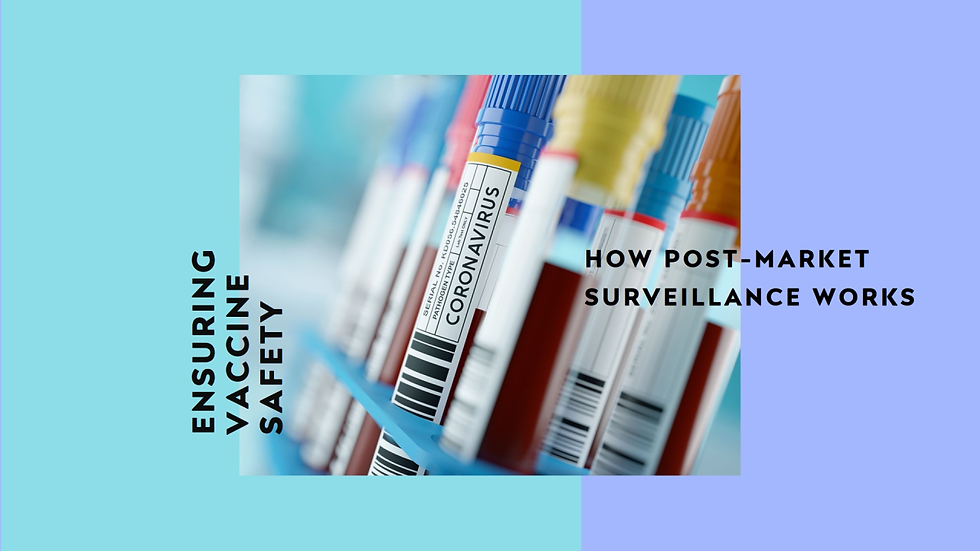
Vaccines are fundamental tools in public health, preventing infectious diseases and saving millions of lives worldwide. Ensuring their safety and effectiveness doesn't end with regulatory approval and initial deployment. Post-market surveillance (PMS) plays a crucial role in continuously monitoring vaccines for any unexpected adverse events and assessing their long-term safety profiles. Vaccine safety databases serve as vital tools in PMS by collecting, analyzing, and reporting real-world data on adverse events following immunization (AEFI). This blog explores how vaccine safety databases support post-market surveillance, their significance in public health, challenges, and future innovations in enhancing vaccine safety monitoring.
Understanding Post-Market Surveillance in Vaccine Safety:
1. Definition and Objectives:
Post-market surveillance involves monitoring vaccines after they are approved and distributed to the general population.
The primary objectives include detecting rare adverse events, assessing vaccine effectiveness in real-world conditions, and ensuring ongoing safety compliance.
2. Role of Vaccine Safety Databases:
Vaccine safety databases serve as centralized repositories for collecting and analyzing AEFI data from various sources, including healthcare providers, patients, and regulatory agencies.
These databases facilitate continuous monitoring, signal detection, and timely response to emerging safety concerns.
Benefits of Using Vaccine Safety Databases for Post-Market Surveillance:
1. Early Detection of Adverse Events:
Real-time data collection and analysis enable early detection of adverse events that may not have been observed during clinical trials.
Prompt identification allows for swift investigation, risk assessment, and implementation of mitigation strategies.
2. Comprehensive Data Analysis:
Vaccine safety databases aggregate diverse data types, including clinical records, adverse event reports, vaccination histories, and demographic information.
Comprehensive analysis enhances understanding of vaccine safety profiles across different populations, age groups, and geographical regions.
3. Signal Detection and Prioritization:
Advanced analytics, including AI and ML algorithms, automate signal detection by identifying statistical associations between vaccines and adverse events.
Prioritization of signals based on severity, frequency, and clinical relevance guides regulatory decisions and public health interventions.
Implementing Vaccine Safety Databases in Post-Market Surveillance:
1. Data Integration and Standardization:
Integration of structured and unstructured data sources ensures comprehensive coverage and uniform reporting standards.
Standardization enhances data quality, interoperability, and comparability across national and international vaccine safety databases.
2. Real-Time Monitoring and Reporting:
Continuous surveillance monitors vaccine safety in real-time, facilitating rapid response to safety signals and emerging health threats.
Automated reporting mechanisms streamline communication between healthcare providers, regulators, and the public.
3. Collaboration and Information Sharing:
Collaborative networks share data, insights, and best practices among healthcare professionals, researchers, and regulatory agencies.
Information sharing enhances global surveillance capabilities and supports coordinated responses to vaccine safety challenges.
Challenges and Considerations:
1. Data Privacy and Security:
Safeguarding sensitive health information is critical to maintaining patient confidentiality and compliance with data protection regulations.
Robust encryption, anonymization techniques, and access controls protect against unauthorized data breaches.
2. Vaccine Hesitancy and Public Perception:
Addressing vaccine hesitancy requires transparent communication, accurate risk communication, and evidence-based decision-making.
Vaccine safety databases play a pivotal role in providing credible information to address public concerns and maintain trust in immunization programs.
3. Regulatory Compliance and Oversight:
Adherence to regulatory requirements ensures transparency, accountability, and ethical use of vaccine safety data.
Regulatory oversight monitors database operations, data management practices, and compliance with reporting obligations.
Case Studies and Success Stories
1. Rotavirus Vaccine Surveillance:
Global vaccine safety databases monitored the introduction of rotavirus vaccines, identifying rare adverse events and enhancing vaccine safety recommendations.
Real-world data informed regulatory decisions and supported continuous monitoring of vaccine effectiveness.
2. COVID-19 Vaccine Monitoring:
Rapid deployment of COVID-19 vaccines necessitated robust post-market surveillance using vaccine safety databases.
Early detection of rare adverse events, such as myocarditis, informed risk assessment and updated vaccination guidelines.
Future Directions in Vaccine Safety Surveillance
1. Integration of Digital Health Technologies:
Advancements in digital health, including wearable devices and telemedicine platforms, enhance real-time data capture and patient monitoring.
Integration with vaccine safety databases improves surveillance capabilities and supports personalized healthcare interventions.
2. AI and ML in Signal Detection:
AI-driven algorithms optimize signal detection by analyzing large-scale, heterogeneous data sets with increased accuracy and efficiency.
Machine learning models predict adverse events, identify high-risk populations, and optimize vaccine safety protocols.
3. Global Collaboration and Data Harmonization:
Strengthening international partnerships and data sharing agreements harmonizes vaccine safety surveillance practices.
Global databases facilitate cross-border analysis, enhance pandemic preparedness, and mitigate global health risks.
Conclusion:
Vaccine safety databases are indispensable tools in post-market surveillance, ensuring continuous monitoring and evaluation of vaccine safety profiles. By leveraging real-world data, advanced analytics, and collaborative networks, these databases enhance early detection of adverse events, support evidence-based decision-making, and uphold public trust in immunization programs. Addressing challenges related to data privacy, vaccine hesitancy, and regulatory compliance is crucial for optimizing vaccine safety surveillance and safeguarding global health. As technology evolves and global collaboration strengthens, the future holds promise for further enhancing vaccine safety monitoring and advancing public health outcomes through comprehensive post-market surveillance efforts.

Comments